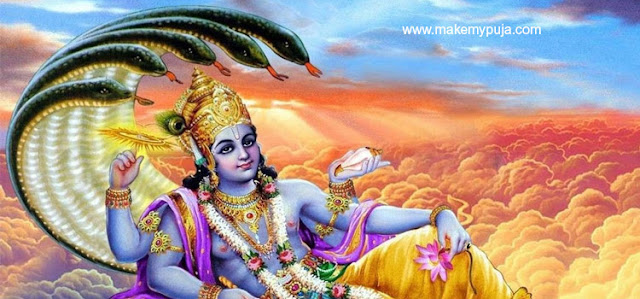Devshayani Ekadashi, also known as Padma Ekadashi, Toli
Ekadashi, Ashadi Ekadashi, Devpodhi Ekadashi, and Hari Shayani Ekadashi in
various parts of India, falls on the 11th day of the dark fortnight
of the Ashadha month of the Hindu calendar. It comes after the famous Jagannath
Rathyatra, and falls in the month of June/July of the English calendar; this
year to fall on 4th July 2017. This day depicts the beginning of the
Chaturmas, a holy period of four months of the Hindu calendar, namely Ashadha,
Shravan, Bhadarva, and Aaso. These four months signify the period when people
can engage in extra devotion, and can gain control over sense gratification.
The holy day of Devshayani Ekadashi is of special significance to the
Vaishnavas, the followers of Lord Vishnu.
What is the
significance of Devshayani Ekadashi?
It is believed that on the day of Devshayani Ekadashi, Lord
Vishnu falls asleep in the Kheer Sagar – the cosmic ocean of milk, on the back
of Shesha Naag – the comic serpent. He observes this Divine Sleep for a period
of four months, and wakes up on the day of Prabhodini Ekadashi in the Kartik
month of the Hindu calendar. However, Lord Vishnu never abandons his devotees
even in his state of sleep. This is why Vaishnavas observe fasting on the day
of Devshayani Ekadashi to honour Lord Vishnu and seek his blessings.
What is the legend
behind Devshayani Ekadashi?
Once, there was a king named Mandata who always kept his
kingdom and his people happy. However, there came an unfortunate time when his
kingdom faced severe drought, starvation, and illness. The king left his
kingdom in search of finding a solution to this adverse period, when he met a
learned sage called Angira on his journey. The sage, after learning about his
situation, advised him to observe a fast on the day of Devshayani Ekadashi, as
it was only Lord Vishnu who could help him bring back the glory to his kingdom.
As directed, King Mandata observed the fast and strictly followed all the
rituals, following which he saw miracles happening! The rains returned to his
kingdom, trade flourished, and his people were blessed with glorious riches.
What are the benefits
of observing Devshayani Ekadashi?
Those who fast on Devshayani Ekadashi and pray to Lord Vishnu
to seek his divine blessings can attain salvation and freedom from worldly avarice.
Fasting on this day also frees one from his past sins, provides energy to face
every challenge of life, enhances the physiological functions of the body,
improves emotional stability, and helps strengthen one’s self-control. To
attain these benefits, you must also observe a fast on this day, knowing that
Lord Vishnu – the Master of the Universe – will answer all the prayers of a
true devotee. Another way of pleasing Lord Vishnu is by performing a
Satyanarayan Katha, where devotees worship the Narayan form of Lord Vishnu. You
can hire MakeMyPuja Pandits to help you arrange for such a Katha at your home
or office to offer gratitude to the Lord for all the pleasures and happiness he
has given you.
The special
Pandharpur Yatra
In the Solapur district of South Maharashtra, a huge
religious processions of pilgrims known as Pandharpur Yatra is carried out
along the banks of the River Chandrabhaga. Here, Lord Vishnu is worshipped in
his local form known as Vitthal. Lakhs of pilgrims join this Yatra, carrying
palanquins with images of various saints of Maharashtra. The pilgrims also
chant hymns dedicated to Lord Vitthal.
Website: https://www.makemypuja.com/

















